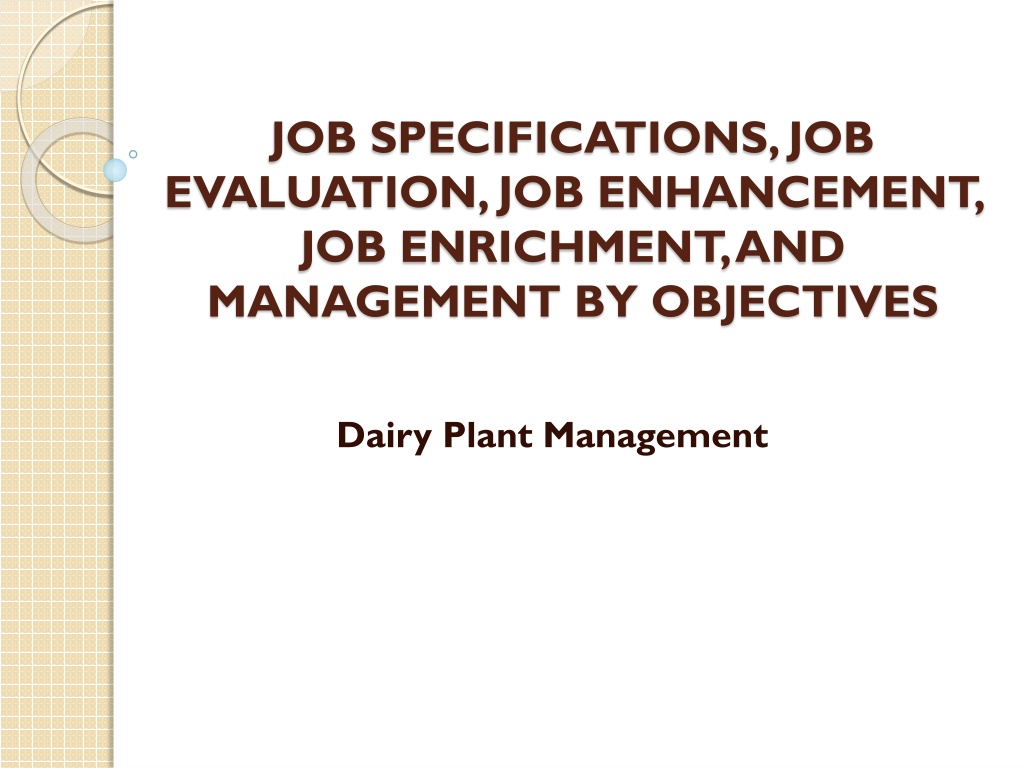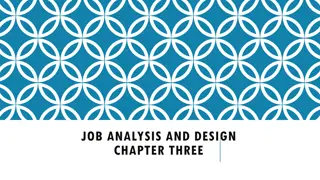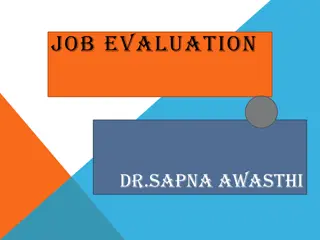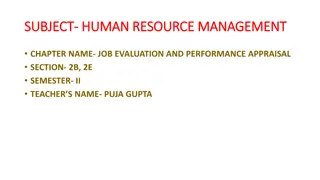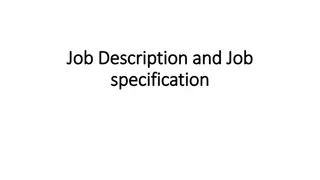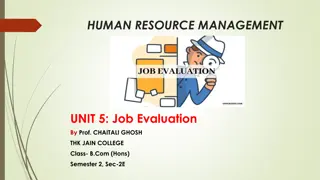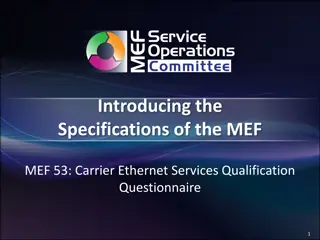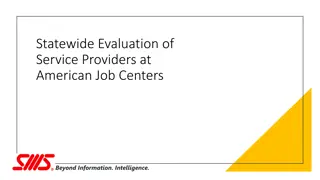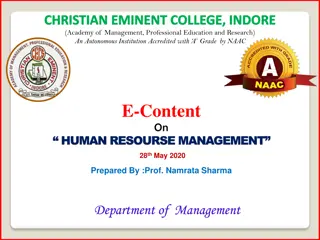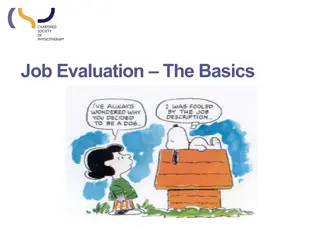Essential Concepts in Job Design, Specifications, Evaluation, and Management
Understanding job design, specifications, evaluation, and management is crucial in organizational effectiveness. Job analysis, motion study, job description, and job specification play key roles in defining and evaluating roles within an organization. Job evaluation determines the relative worth of jobs, guiding pay differentials. This comprehensive guide provides insights into job-related concepts critical for effective workforce management.
Download Presentation

Please find below an Image/Link to download the presentation.
The content on the website is provided AS IS for your information and personal use only. It may not be sold, licensed, or shared on other websites without obtaining consent from the author. Download presentation by click this link. If you encounter any issues during the download, it is possible that the publisher has removed the file from their server.
E N D
Presentation Transcript
JOB SPECIFICATIONS, JOB EVALUATION, JOB ENHANCEMENT, JOB ENRICHMENT, AND MANAGEMENT BY OBJECTIVES Dairy Plant Management
Job Design Job design means specifying the contents and methods of a job. Job is any specific work undertaken to accomplish the goal of an organization Job Analysis: is the process of studying and collecting information relating to the operations and responsibilities of a specific job. The immediate products of this analysis are job descriptions and job specifications.
Motion study: Motions study is one of the ways of studying job. It is a process of analyzing a job to find the easiest, most effective, and most economical method of doing it. As such, motion study is a part of the job design function. Job description: It is an organized, factual statement of the duties and responsibilities of a specific job. In brief, it should tell what is to be done, how it is to be done, and why. It is a standard of function, in that it defines the appropriate and authorized content of a job. Job specification: It is a statement of the minimum acceptable human qualities necessary to perform a job properly. It is a standard of personnel and designates the qualities required for acceptable performance.
Job Specification Job specification is the delineation of the knowledge, skills, and abilities along with the associated education, training, and experience required to successfully perform within a position. The stipulated criteria normally constitute the minimum recruiting criteria or minimum qualifications for the position.
Job Specification contd. Ajob specification should include: Physical characteristics as height, weight, sight, physical structure, health, etc. Characteristics as decision-making ability, analytical view, mental ability etc. Personnel characteristics as enthusiasm, leadership qualities, integrity etc. Responsibility, i.e., the sense of responsibility in a person to be appointed on the job. The job description assists the candidate to understand the requirements of the job and also helps the management in appraising the performance of the employee. behavior, mental stability,
Job Evaluation Job evaluation deals with money and work. It determines the relative worth or money value of jobs. Definitions of job evaluation: International Labor Organization defined job evaluation as "an attempt to determine and compare demands which the normal performance of a particular job makes on normal workers without taking into account the individual abilities or performance of the workers concerned." Wendell L. French defined job evaluation as, "a process of determining the relative worth of the various jobs within the organization, so that differential wages may be paid to jobs of different worth."
Objectives of job evaluation To gather data and information relating to job description, job specification and employee specifications of various jobs in an organization. To compare the duties, responsibilities and demands of a job with that of other jobs. To determine the hierarchy and place of various jobs in an organization. To determine the ranks or grades of various jobs. To ensure fair and equitable wages on the basis of relative worth or value of jobs. In other words, equal wages are fixed to the jobs of equal worth or value. To minimize wage discrimination based on sex, age, caste, region,religion etc.
Job Enrichment Job enrichment is enriching the jobs, adding more qualitative aspects. It is vertical expansion of jobs. The qualitative expansion such as increased responsibilities, more powers and autonomy are special features of job enrichment. Individual employee gets an opportunity to modify his performance and increase merit.Management has to provide opportunities which enrich jobs. Employees should feel become motivator as pointed by Herzberg. enrichment should
Job Enhancement Job enhancement is when an employee is given new responsibilities or tasks that gives him/her the opportunity to develop his/her skills or abilities. A production person may be placed in marketing department and he will be more encouraged to get new assignment with his basic knowledge and on the other hand organisation will be benefited by utilizing his services for both activities. Job enhancement is an effective way to help employees improve their essential skills, and it doesn t require a lot of resources to be successful. It can: Better prepare employees for promotions and organizational changes Help address skill shortages Improve performance Increase job satisfaction Increase motivation and self-confidence Reduce employee turnover and stress Support a healthy learning culture in the workplace.
Management by Objectives Management by Objectives (MBO) is a process whereby the superior and subordinate managers of an organization jointly identify its common goals, define each individual's major areas of responsibility in terms of results expected of him and use these measures of guides for operating the unit and assessing the contribution of its members.
Management by Objective Contd. The MBO process is undertaken along the following lines: The subordinate and superior jointly determine goals to be accomplished during the appraisal period and what level of performance is necessary for the subordinate to satisfactorily achieve specific goals. During the appraisal period, the superior and subordinate update and alter goals as necessary due to changes in the business environment. Both superior and subordinate jointly discuss whether the subordinate achieved the goals or not.If not,they should identify the reasons for deviation like strike/lock-out,market change etc. Peter Drucker for the first time explored the management by objectives for getting improved organizational performance and employee satisfaction. As management accepted, the MBO is spreading to cover even non-business organizations to manage their performance as systematic setting of objectives and goals lead to better results. principles are widely
Management by Objective Contd. The setting of overall objectives is done by management after considering the strengths, weaknesses, opportunities and threats. The key functional areas are identified first to formulate overall objectives. Key functional areas are those which have maximum impact on the overall performance. The key functional areas' performance is to be evaluated to understand their contribution in the organization. The objectives are generally used as measuring scales of performances.The inputs required for achieving the objectives are also appraised. Time and money factors are crucial items to have results-oriented performance. The department goals are guiding factors for deciding branch goals. Readjustment of department and sectional objectives is essential to arrive at practical and feasible objectives. .
Management by Objective Contd. The individual supervisor's objectives are developed based on sectional objectives. The employees-supervisor relationship is also discussed while formulating their objectives. The supervisor's objectives usually known as targets are quantifiable, feasible and are time and cost oriented.Their performance is judged on these bases. The corporate objectives are achieved through corporate plans and strategies. Similarly departmental, sectional and individual objectives are achieved through departmental plans,sectional plans and action plans respectively.
Management by Objective Contd. The performance achieved is compared with the objectives to find out the position, causes and constraints of achievements in the areas of organizational performance and employee's satisfaction. The appraisal system is diagnostic rather than purely evaluative. The suggestions are brought forward through mutual discussion and personal considerations.This is perpetual functions e.g., deciding objectives, plan formations, actions, evaluation, diagnosis and reformulation of objectives, plans,actions and suggestions. Goals setting are the first and final step in job-designing. The jobs are framed, described and allocated as per the goals set by organization which are achieved by the employees. The deviations between performance and goals are diagnosed and improved goals are set for organizational performance and employees' satisfaction. further improvement of
